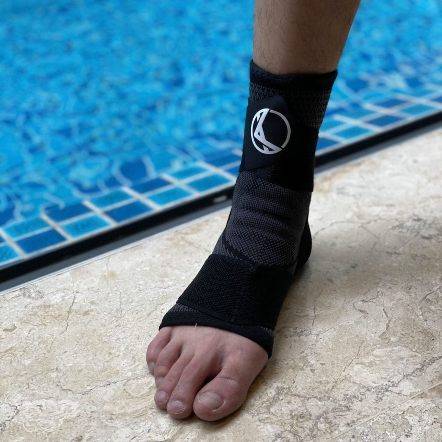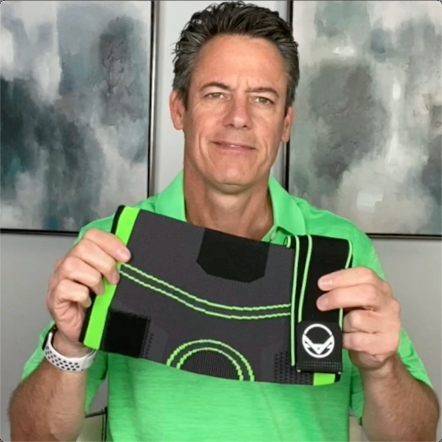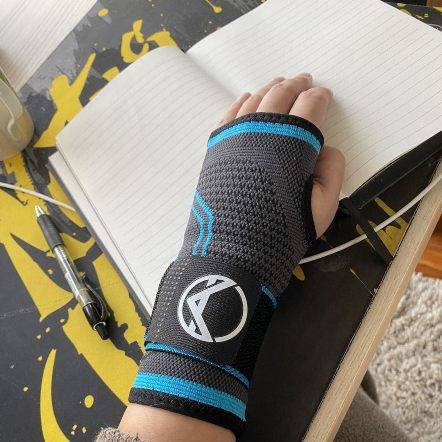
How Effective Are Compression Socks For Plantar Fasciitis?
June 29, 2023 | 3 Mins Read
TABLE OF CONTENTS
1. What Is Plantar Fasciitis and What Causes Them?
2. Are Compression Socks Good For Plantar Fasciitis?
3. Best Compression Socks for Plantar Fasciitis
4. Who Can Benefit from Koprez Compression Socks?
5. When Should I Wear Compression Socks for Plantar Fasciitis?
6. Can You Sleep in Compression Socks for Plantar Fasciitis?
7. How Long Can You Wear Compression Socks for Plantar Fasciitis?
The burning. The sore heel. The sharp stabbing pain that stops you in your tracks. 1 out of 10 people experiences plantar fasciitis, a condition that causes inflammation of the band of tissue running along the bottom of your foot, and it can be very painful.
If you're dealing with the symptoms of plantar fasciitis, wearing compression socks can offer relief and support during your recovery.
Plantar fasciitis refers to the inflammation of the plantar fascia, a thick band of tissue that connects the heel bone to the toes and supports the arch of the foot. When this tissue becomes irritated or overstretched, it can lead to heel pain and discomfort. Several factors contribute to the development of plantar fasciitis, including:
People aim for a treatments that are easiest, cheapest, and most convenient for them. With plantar fasciitis lasting an average of five months, compression socks are the best conservative method, advocated by many doctors and physical therapists, as they can help decrease swelling and provide localized support.
Compression socks are widely accepted as a form of conservative treatment for plantar fasciitis as it offers symptomatic relief within just 4 - 6 hours of regular use.

Certain individuals are more at risk of developing plantar fasciitis due to their lifestyle or physical condition. Those most likely to experience the pain associated with this condition include:
Plantar fasciitis is most commonly observed in individuals between the ages of 40 and 60. As we age, the flexibility and elasticity of our tissues naturally decrease, making the plantar fascia more susceptible to inflammation and injury.
Additionally, the wear and tear accumulated over the years can contribute to the development of plantar fasciitis. It is important to be aware of this increased risk and take preventive measures or seek appropriate treatment if symptoms arise.
Athletes who engage in activities that place excessive stress on the feet, such as long-distance running, ballet dancing, and aerobic dance, are more prone to developing plantar fasciitis. The repetitive impact and strain on the plantar fascia during these high-impact activities can lead to micro-tears and inflammation in the tissue.
It is crucial for athletes to incorporate proper warm-up routines, stretching exercises, and adequate rest periods into their training regimen to reduce the risk of plantar fasciitis.
Certain occupations require individuals to spend prolonged periods standing or walking on hard surfaces. Jobs such as retail workers, factory workers, healthcare professionals, and construction workers are examples of occupations that can strain the plantar fascia.
Excess weight places additional pressure on the feet, increasing the likelihood of developing plantar fasciitis. The excess load on the plantar fascia can lead to overstretching and inflammation.
Maintaining a healthy body weight is crucial in reducing the risk of plantar fasciitis. Adopting a balanced diet, engaging in regular physical activity, and managing weight effectively can help alleviate the strain on the feet and reduce the chances of developing this condition.
Compression socks can be worn for plantar fasciitis, particularly at night while you sleep. Many people with plantar fasciitis experience intense heel pain in the morning, known as "first-step pain." Wearing compression socks at night can help alleviate this discomfort by reducing swelling and promoting blood circulation.
The gentle pressure applied by compression socks aids in reducing inflammation and delivering essential nutrients to the affected area, aiding in the healing process.
Additionally, compression socks provide support to the plantar fascia, helping maintain its natural alignment and preventing overstretching during sleep, thus reducing pain and promoting better sleep quality.
Read here to learn when and when should you not wear compression socks.

As was previously mentioned, sleeping in compression socks can help reduce pain caused by plantar fasciitis. Wearing compression socks for plantar fasciitis while you sleep can offer much-needed relief and aid in your recovery. It is perfectly safe to sleep in compression socks. In fact, you can wear compression socks 24 hours a day if desired.
However, it is crucial to ensure proper hygiene and avoid wearing the same pair continuously. Regularly wash and rotate your compression socks to maintain their effectiveness and prevent any potential skin irritation.
We recommend wearing them during the day, especially if they are on their feet a lot. Others may benefit from wearing them at night to reduce morning pain which is a common symptom of plantar fasciitis.
You can expect immediate symptomatic relief after wearing compression socks for plantar fasciitis. However, it can take up to 8 weeks of consistent use of graduated compression socks to experience the full healing benefits. We recommend reading this guide for a more comprehensive information on how long it might take for compression socks to work.
When selecting compression socks for plantar fasciitis, it is crucial to consider the compression level. Opt for socks with graduated compression, which means they exert more pressure at the ankle and gradually decrease towards the calf. This design promotes better blood flow by assisting the veins in pumping blood back up to the heart.
The graduated compression also helps reduce swelling and inflammation in the foot, which are common symptoms of plantar fasciitis. By improving circulation, these socks can aid in the healing process and provide relief from discomfort.
Another essential feature to look for in compression socks for plantar fasciitis is arch support. The plantar fascia is a band of tissue that runs along the arch of the foot, and excessive pressure on this area can contribute to the development of plantar fasciitis.
Compression socks with built-in arch support provide additional cushioning and help alleviate pressure on the plantar fascia. This feature promotes proper foot alignment, reduces strain on the arch, and enhances overall stability. By supporting the arch, these socks can help relieve pain and discomfort associated with plantar fasciitis.
Opting for compression socks with extra padding in the heel and ball of the foot is beneficial for individuals with plantar fasciitis. These areas of the foot often experience the most impact during walking or running, leading to increased discomfort for those with plantar fasciitis.
Socks with additional cushioning in these key areas provide enhanced shock absorption, reducing the impact on the plantar fascia and minimizing pain. The extra padding also helps distribute pressure more evenly across the foot, providing added comfort and support.
It is essential to select compression socks made from breathable and moisture-wicking materials. Plantar fasciitis can be exacerbated by excessive moisture and the growth of bacteria on the feet.
Moisture-wicking fabrics, such as those infused with synthetic fibers like nylon or polyester, efficiently draw moisture away from the skin and allow it to evaporate quickly. This helps keep the feet dry and prevents the build-up of sweat, reducing the risk of bacterial growth and potential foot odor. Choosing compression socks with moisture-wicking properties ensures a comfortable and hygienic environment for the feet, promoting overall foot health.
These features work together to provide optimal support, alleviate discomfort, and promote a more comfortable and effective recovery process.






References
Author

Claire Evans worked as the content marketing manager at Koprez. Claire combined a background of writing and editing, marketing, and patient education to best serve consumers, fitness enthusiasts, athletes, and anyone who relies on the Koprez brand for helpful information.
Koprez® Featured Products


"I sprain my wrist super often, so I decided to try out this sleeve. This is game-changing! I've been using it for a while now, and my wrists feel amazing. I haven't gotten in any injuries since using it too. It just makes my wrists feel so supported."
Alexis A.


"Use this for my boxing training. It is a very comfortable brace and does not move out of position during skipping ropes and sparring sessions. I use it while running too. Probably the best brace I've purchased throughout the years. It is very flexible. Makes me look like a pro! :)"
Samuel L.


"I've just got back to running after a couple of years of being plagued by injury. These compressions socks are helping give me peace of mind while I build up my distance again. They are the perfect level of compression, super comfy, and very high quality. Feel great while on a run, and looks great in the orange colour I have!"
Dave R.


"I have a weak ankle, and the Koprez ankle sleeve has been a lifesaver. Wear it every day. Super breathable and comfortable. Like wearing a cool sporty looking sock!"
James F.


"This is the best knee sleeve I've ever tried. It's now a must-have for all my exercises. A few years ago, I had an accident that damaged my knees, but with Koprez I can be active again with no knee pains at all. It's been truly amazing!"
Alex M.


"One of the best purchases I've ever made. It fits your legs all the way from top to bottom, great snug fit, gives you support and definitely helps during rehab and training."
Rafael A.


"I had a minor elbow injury, and Koprez sleeve was super supportive and definitely helped me recover faster. I still use the sleeve to prevent further injury. So far, so good. Very comfortable and does not feel hot at all. Highly recommend!"
Corey B.


"It's really been a game-changer for me. It allows me to exercise a lot longer than I used to. Now my knees don't hurt, and they're not uncomfortable at all."
Mike P.


"Great product!!"
Harold


"I have carpal tunnel, and this brace has helped me work pain-free. Love the materials, and I can feel my wrists slowly getting better, even when I don't wear them!"
Christopher J.


"I wanted to try out these sleeves to improve my squats and deadlift in the gym without worrying about injuring my knees. They stayed up throughout the entire gym session, and my knees feel super supported. Now I can do what I love for years to come. "
Corbin C.